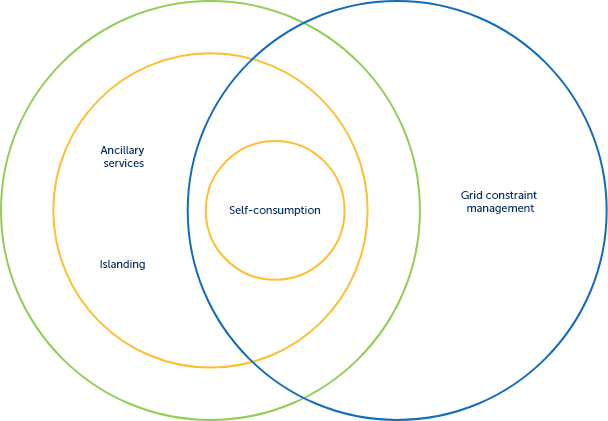MULTI-SERVICE STORAGE & ISLANDING
Single-service stationary battery applications still face major economic hurdles. The various battery storage technologies have reached a high degree of maturity whereas most projects are still struggling with cost-effectiveness.
BUSINESS CASE
InterFlex investigated the combined implementation of complementary services in dedicated storage assets in the aim of making the battery a competitive system asset. Combined services covered local grid congestion management, islanding support, customer services such as renewable self-consumption as well as ancillary services.
Islanding of 100% renewable energy microgrids is a specific sub-section of this business case, since batteries remain the central grid forming and supporting element of an islanded system. InterFlex examined the seamless transition between grid-connected and islanding mode, in order to increase the resiliency in specific locations (rural areas, islands), or in response to local initiatives (Local Energy Communities).
The abovementioned economic considerations equally apply: InterFlex explored the combination of several storage services in order to approach the economic break-even.
The implementation of combined services for the use of stationary batteries formed part of the French and Swedish demonstrators.
In the village of Simris in the south of Sweden, E.ON implemented a microgrid able to run in an islanded mode with 100% renewable generation: a wind turbine as main generation, supported by a ground-mounted PV power plant and two stationary batteries (Li-ion and Redox-flow technologies). The central battery system was in charge of the instantaneous balancing of the microgrid in islanded mode (voltage and frequency control). When connected to the main grid, the batteries offered ancillary services to the TSO including constraint management, peak lopping, and voltage control.
In the French demonstrator Nice Smart Valley, two different sites were equipped with batteries to test the multi-service approach, while depending on the nature of the service, either the DSO itself or market players (ENGIE) were operating the respective batteries. On Sainte Marguerite, a small Mediterranean island near the coast of the French Riviera, Enedis, ENGIE and Socomec implemented a microgrid with islanding capacities based on two batteries. A first battery was remote-controlled by Enedis from its Regional Control Centre and served to guarantee the electric system stability in case of islanding. A second battery was deployed by ENGIE primarily to provide self-consumption to local customers, whereas the battery also served to support the DSO’s battery during islanding operation.
In Carros, a municipality in the metropolitan area of Nice, Enedis and ENGIE shared the exploitation of a single battery for grid constraint management and collective self- consumption respectively.

Simris microgrid, Sweden
2 local microgrid batteries operated by the DSO:
1. Seamless MV islanding by the DSO to reinforce the resilience of areas where power supply is critical
2. Citizen Energy Community: maximizing village selfconsumption while the grid serves as a backup-vrtual islanding & active customer involvement (P2P) to reduce battery sizing
3. Ancillary services in grid-connected mode
2 interconnected Battery storage systems: one microgrid-forming battery (owned & operated by the DSO for the demonstration):
1. Remote-controlled seamless MV islanding system for the DSO to ensure the continuity of supply in areas were no backup is provided by the grid
2. Contractual exploitation agreement with an aggregator for storage monetization outside islanding periods – ancillary services and one commercial battery (aggregator asset)
and one commercial battery (aggregator asset)
1. Grid-support to the DSO during islanding periods
2. Remote steered operation by the aggregator for ancillary services and markets
3. and local self-consumption contracts
Carros, France
Shared & alternating use of a single battery by both the DSO and aggregator:
1. Local use of the battery by the DSO to relieve peak loads on the distribution grid
2. Battery state of charge optimisation by the aggregator to maximise the customer benefit in a collective self consumption operation: several customers make use of the same centralised battery
MAIN ACHIEVEMENTS
Multi-service storage and islanding can help to avoid the GHG emissions of fossil-fuelled gensets, by replacing them with local renewable energy that can be used to ensure electricity supply in case of an incident on the main network. Enedis and ENGIE explored potentially innovative business models including the shared use of a common battery for both commercial and grid services.
Among the achievements of the InterFlex demonstrators on multi-service storage and islanding shall be cited:
- Successful technical multi-service & multi-battery storage operation through IoT/Cloud remote control
- Multi-service offers and potential value stacking (collective self-consumption, ancillary services, local grid support)
- Multi-service & multi-battery contractual framework between regulated and market players (DSO-aggregator)
- Seamless MV islanding for enhanced resilience
- Microgrid operation in Island mode: power quality and grid stability (frequency, voltage control) thanks to advanced inverter functions
- Electrical safety (protection management during islanding)
- Sizing method to design an island system, including the evaluation of customer flexibilities to reduce the size of central batteries
CHALLENGES & RECOMMENDATIONS
Remaining challenges include the following elements:
- Despite considerable progress, most stationary battery storage business models are not yet economically viable. However, battery storage system costs are constantly decreasing and there are potential cost savings bound to adapted grid connection fees and reduced tax schemes. Moreover, the price volatility on global markets is expected to increase in the future, thereby fostering the development of storage systems.
- Matching business-related battery services generally leads to technically complex and expensive solutions, particularly when dealing with different power and energy characteristics and diverging requirements regarding the time response of the power electronics.
- Few off-the-shelf battery system solutions exist, which limits scalability in general and economies of scale in particular.
- Batteries and battery-bound flexibilities will be essential constituents of tomorrow’s energy system. Important national and local administrative hurdles have been experienced during field implementation (risks, authorizations, environmental & fire protection) and should be lowered considering the interest of the batteries for the energy transition.
- Similar conclusions apply to the administrative authorizations needed for photovoltaic installations, hindering the further development of local renewable generation and associated business models.
